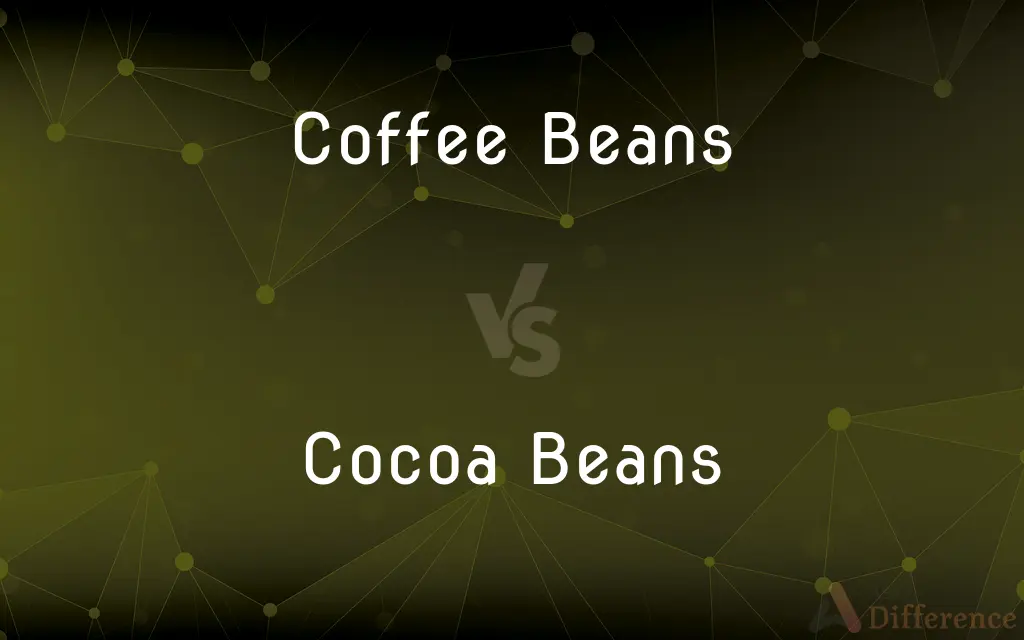Coffee Beans vs. Cocoa Beans — What's the Difference?
By Tayyaba Rehman — Published on November 5, 2023
Coffee Beans are seeds from the Coffea plant, used to make coffee. Cocoa Beans are seeds from Theobroma cacao trees, used to produce chocolate.

Difference Between Coffee Beans and Cocoa Beans
Table of Contents
ADVERTISEMENT
Key Differences
Coffee Beans and Cocoa Beans, both cherished globally, have distinct origins and uses. Coffee Beans come from the Coffea plant, primarily cultivated in tropical regions. They are the primary ingredient in brewing the beverage coffee. These beans undergo a rigorous process of picking, drying, roasting, and grinding before they're ready for consumption.
Cocoa Beans, on the other hand, are the primary constituent in chocolate production. These beans are seeds from the pods of Theobroma cacao trees. Predominantly grown in regions close to the Equator, Cocoa Beans undergo fermentation, drying, roasting, and grinding to produce cocoa powder, cocoa butter, and ultimately, chocolate.
At first glance, Coffee Beans and Cocoa Beans might seem similar, especially in their raw form. However, their tastes, aroma, and nutritional profiles are quite distinct. While Coffee Beans offer a bitter and aromatic taste leading to the invigorating effect of coffee, Cocoa Beans possess a more varied flavor profile, ranging from bitter to sweet, foundational in chocolates and various cocoa products.
Agriculturally, both Coffee Beans and Cocoa Beans require specific climates. Coffee is often cultivated at higher altitudes in tropical regions. Cocoa cultivation favors humid, tropical climates with consistent rainfall. Despite their differences, both beans are integral to global trade and have rich histories intertwined with culture and tradition.
While Coffee Beans energize morning routines for many, Cocoa Beans satiate sweet cravings and are foundational in desserts. Both beans, with their unique attributes and contributions, have carved niches in global culinary landscapes.
ADVERTISEMENT
Comparison Chart
Origin
Seeds from the Coffea plant.
Seeds from Theobroma cacao trees.
Primary Use
Brewed to make coffee.
Processed to produce chocolate.
Flavor Profile
Bitter and aromatic.
Ranges from bitter to sweet.
Growing Conditions
Higher altitudes in tropical regions.
Humid, tropical climates with consistent rainfall.
Economic Value
Major global commodity, especially for countries like Brazil.
Integral for chocolate industry; prominent in West Africa.
Compare with Definitions
Coffee Beans
Seeds of the Coffea plant.
Roasted Coffee Beans emit a captivating aroma.
Cocoa Beans
Fundamental ingredient in chocolate production.
Finely processed Cocoa Beans result in smoother chocolate.
Coffee Beans
Beans undergo roasting to enhance flavor.
Darker roasts give Coffee Beans a more intense flavor.
Cocoa Beans
Cultivated primarily near the Equator.
West Africa is a significant producer of Cocoa Beans.
Coffee Beans
Primary ingredient for brewing coffee.
Quality Coffee Beans ensure a rich and robust brew.
Cocoa Beans
Undergo fermentation for flavor development.
The taste of the chocolate depends greatly on how the Cocoa Beans are fermented.
Coffee Beans
Often grown in tropical high-altitude areas.
Columbia's highlands produce exquisite Coffee Beans.
Cocoa Beans
Seeds from Theobroma cacao tree pods.
Cocoa Beans are the essence of all chocolate products.
Coffee Beans
Integral to global trade and commerce.
Many countries rely heavily on exporting Coffee Beans.
Cocoa Beans
Cocoa Beans yield cocoa powder and cocoa butter.
The separation of components from Cocoa Beans enables diverse chocolate products.
Common Curiosities
Where do Cocoa Beans come from?
Cocoa Beans are the seeds from the pods of Theobroma cacao trees, primarily used to make chocolate.
What's the primary purpose of Cocoa Beans?
Cocoa Beans are processed to produce chocolate and related products.
Can you eat Coffee Beans directly?
Yes, you can eat roasted Coffee Beans, and they're often used as a garnish in desserts.
How are Coffee Beans processed for consumption?
Coffee Beans are picked, dried, roasted, and ground to prepare them for brewing.
Do Coffee Beans have caffeine?
Yes, Coffee Beans contain caffeine, which gives coffee its stimulating effect.
What are Coffee Beans?
Coffee Beans are seeds derived from the Coffea plant, used predominantly to brew coffee.
Are Cocoa Beans naturally sweet?
No, raw Cocoa Beans are typically bitter; sweetness is added during chocolate production.
Where is the majority of the world's Cocoa Beans grown?
West Africa, especially Côte d'Ivoire and Ghana, dominates global Cocoa Beans production.
How are the flavors of Coffee Beans categorized?
Coffee Beans' flavors are influenced by origin, roast level, and processing method, leading to profiles from fruity to chocolaty.
How does the fermentation process affect Cocoa Beans?
Fermentation develops the flavor profile of Cocoa Beans, making them less bitter and more suitable for chocolate production.
Which countries are major producers of Coffee Beans?
Brazil, Vietnam, and Colombia are among the top producers of Coffee Beans.
What health benefits are associated with Coffee Beans?
Coffee Beans are rich in antioxidants, and moderate consumption is linked to improved brain health and reduced risk of certain diseases.
Can both Coffee Beans and Cocoa Beans be consumed raw?
While they can be consumed raw, both beans are typically processed for enhanced flavor and edibility.
Is there caffeine in Cocoa Beans?
Yes, Cocoa Beans contain a small amount of caffeine but less than Coffee Beans.
Are Cocoa Beans healthy?
Yes, Cocoa Beans are packed with antioxidants and can have cardiovascular and mood-enhancing benefits when consumed in moderation.
Share Your Discovery

Previous Comparison
Work In Progress vs. Work In Process
Next Comparison
KJ vs. KCalAuthor Spotlight
Written by
Tayyaba RehmanTayyaba Rehman is a distinguished writer, currently serving as a primary contributor to askdifference.com. As a researcher in semantics and etymology, Tayyaba's passion for the complexity of languages and their distinctions has found a perfect home on the platform. Tayyaba delves into the intricacies of language, distinguishing between commonly confused words and phrases, thereby providing clarity for readers worldwide.













































